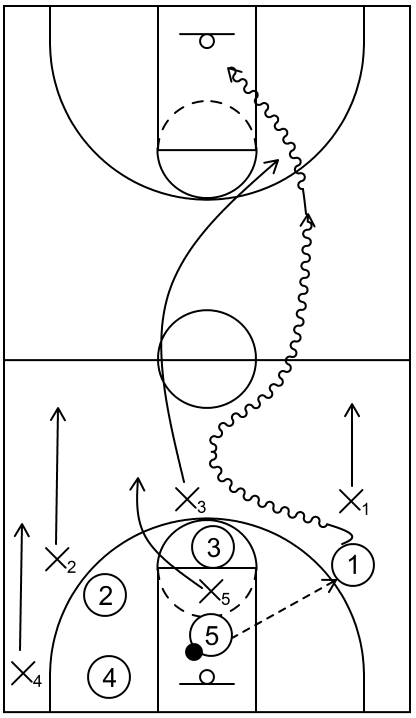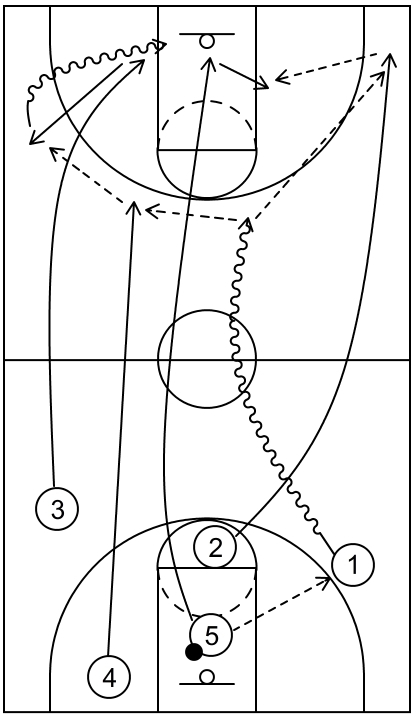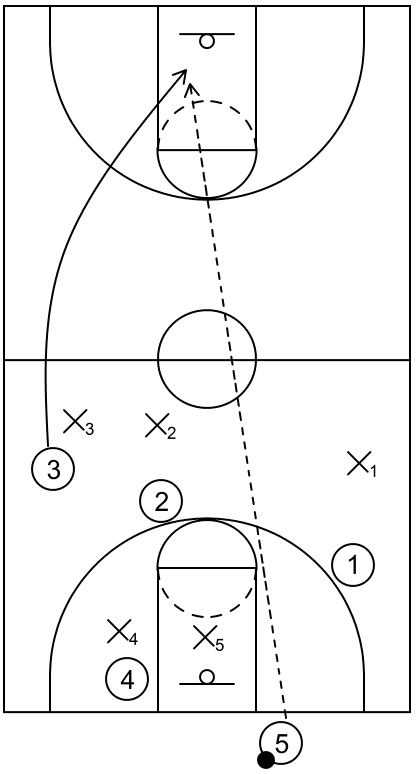What is the outlet pass in basketball
The outlet pass is comprised of action that occurs when a player throws the basketball to a teammate, generally as a method to initiate and execute transition offense, typically after gaining possession of the ball via a defensive rebound or in certain instances, as a baseline inbound thrower.
It should also be noted that the outlet pass is usually a type of air pass as opposed to a standard bounce pass.
Furthermore, a standard chest pass could be utilized as the practical outlet pass, particularly when it is thrown to a teammate that is within the same backcourt as the potential passer.
However, a baseball pass or overhead pass could also be used as the functional outlet pass, especially when it is thrown to a teammate that is within the opposite frontcourt, further away from the potential passer.
Moreover, an underhand pass could also be used as well to pass the ball to a teammate that is a great distance away from the passer. To execute the underhand pass, a player in possession of the ball places it under their hand and then throws it to a teammate with an arm motion that is somewhat similar to throwing a bowling ball.
In addition to that, when a player in the backcourt executes a long distance outlet pass to a teammate that is able to quickly score near the basket in the frontcourt, it is typically referred to as a touchdown pass.
Why is the outlet pass potentially useful
The outlet pass is potentially useful because it can be implemented to create possible transition offense scoring opportunities, particularly when the opposing team does not implement adequate transition defense to protect their basket effectively.
To clarify, when a player gains possession of the basketball, either due to a defensive rebound after an opponent’s missed shot or by grabbing the ball out of the basket ring to execute an inbound pass after an awarded score, that same player would then have an opportunity to outlet the ball, notably as a long distance pass into the opposite frontcourt or perhaps as a shorter pass in the same backcourt.
Following that, the player that receives the outlet pass could then generate scoring opportunities, mainly via transition offensive strategies such as the primary break, secondary break, or numbered fast break.
This is an even greater factor if there are more offensive players than defenders during transition, hence resulting in a numbers advantage for the offensive team.
What are examples of potential scoring options after the outlet pass occurs
Example 1

This is an example of a scoring option via a primary break that includes a 2-on-1 numbers advantage. To start, 5 secures the ball via a defensive rebound while 2 and 3 cut towards the frontcourt area.
Also, at the same time, X2 gets back during transition defense to protect the basket. Following that, 2 could receive the ball via an outlet pass from 5.
Next, 2 could dribble towards the basket while 3 continues to cut towards the basket as well. Afterwards, 2 could score at the rim, especially if X2 does not attempt to contain the dribble action of 2.
Otherwise, if X2 does attempt to contain the dribble action, as shown with the arrow, then 3 could receive the ball via a short drop pass by 2. After that, 3 could quickly score at the rim with a layup or dunk.
Example 2

This is an example that essentially showcases poor transition defense which then leads to easy transition offense, particularly by way of a one man fast break.
To begin, 5 secures the ball via a defensive rebound and following that, 1 receives the ball via the outlet pass by 5. At the same time, X1 attempts to implement on-ball defensive pressure against 1.
However, 1 is able to get by X1 with basketball moves such as the crossover dribble while the other defenders also sprint back towards the opposite side of the court.
Additionally, X3 attempts to sprint back to contain 1 but as that occurs, 1 is able to use speed and quickness to get by X3 which then leads to an uncontested layup or dunk at the rim.
Example 3

This is an example of a transition offense situation which features potential scoring options by way of a pitch ahead pass. To start, 5 secures the ball via a defensive rebound and afterwards, 1 receives the ball from 5 via the outlet pass.
Also, as that happens, 2 and 3 begin to sprint towards the free-throw line extended areas in the frontcourt. Following that, 1 begins to dribble towards the middle of the court.
Next, 2 could receive the ball from 1 via the pitch ahead pass and take the three-point jump shot if open.
Conversely, 3 could receive the ball from 1 via the pitch ahead pass and take an open jump shot or dribble towards the basket to score at the rim via a layup or dunk.
Example 4

This is an example of potential scoring options via a numbered fast break, particularly after primary break ends and secondary break begins.
To start, 5 secures the ball via a defensive rebound and following that, 1 receives the ball from 5 via an outlet pass.
Next, 1 dribbles toward the right slot, 2 cuts to the right side corner, 3 cuts to the left side low post block, 4 cuts to the left slot, and 5 initially runs to the rim but then cuts to the right side low post block.
After that, 2 could receive the ball from 1 and take the quick three-point shot if that is available. If the shot is not there, then 5 could receive the ball from 2 and score via a low post move near the basket.
Alternatively, 4 could receive the ball from 1 instead and take the three-point jump shot if that is open. Otherwise, 3 could pop back towards the left side wing to receive the ball from 4.
From there, 3 could isolate and attempt to dribble towards the basket and score at the rim or possibly attempt to score a mid-range field goal near the perimeter or three-point field goal beyond the arc.
Example 5

This is an example of a baseline inbound touchdown pass after an opponent scores. Essentially, in this instance, after the opposing team scores the basketball offensively, they erroneously do not immediately convert into a transition defensive mindset.
When that occurs, one or more current transition offensive players would then have the opportunity to sprint towards the basket before the defense realizes what is happening.
For this particular demonstration, 5 grabs the ball out of the basket ring and then 5 steps out of bounds near the adjacent baseline to execute the inbound pass.
As that happens, 3 quickly sprints towards the rim in the frontcourt while the various current defenders do not effectively sprint back to protect the basket.
Next, 3 receives a long distance touchdown pass from 5 and afterwards, 3 scores at the rim with a layup or dunk.
Related: Outlet Touchdown Passes by Kevin Love during the 2014-15 NBA Season – YouTube